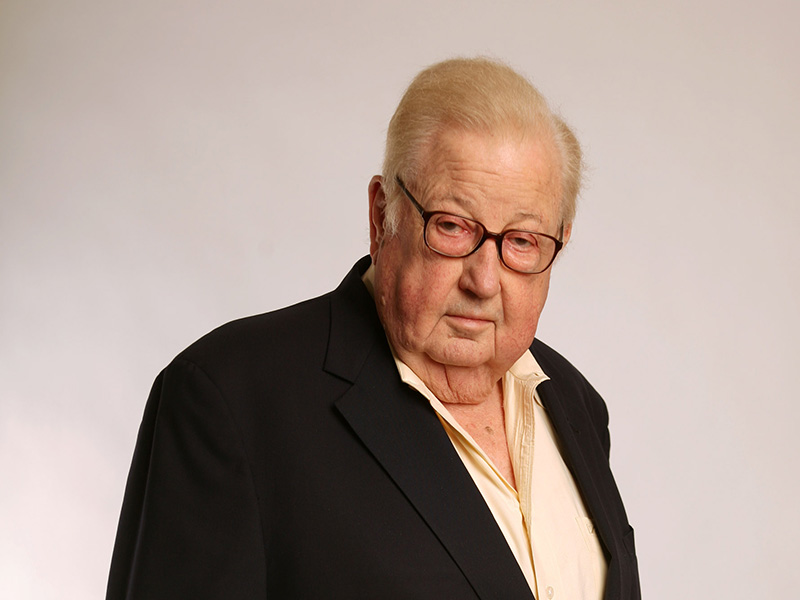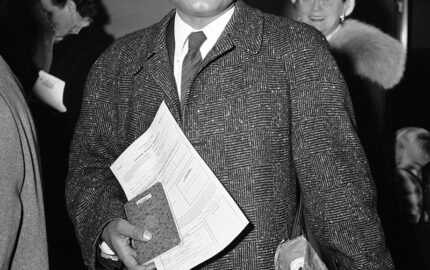Robert Drew, an innovator in broadcast journalism whose documentaries about John F. Kennedy helped define the cinéma vérité style of filmmaking, died on Wednesday at his home in Connecticut. He was 90.
Before his Nieman Fellowship in 1955, Drew was an editor at Life magazine who had created a number of television documentaries for NBC. In a 2001 essay for Nieman Reports, Drew described the early documentaries that he and others had created as “audio lectures illustrated with pictures,” which weren’t using the full capabilities of the medium. He studied short stories, modern stage plays and novels at Harvard, hoping to see how those formats could be translated to television. His research formed the basis for a 1955 Nieman Reports essay, “See It Then: Notes on Television Journalism.”
Five years later, Drew put his lessons into practice with “Primary,” considered the first example of cinéma vérité filmmaking. Using relatively lightweight cameras and audio equipment, Drew and cinematographer Richard Leacock followed John F. Kennedy during his 1960 presidential primary campaign against Hubert Humphrey in Wisconsin. The film eschewed the on-camera narration and staged shots of traditional television documentary, offering instead a fly-on-the-wall perspective on the machinations and stagecraft of the political campaign. It was inducted into the Library of Congress’ National Film Registry in 1990.
Drew would revisit Kennedy in the 1963 documentary “Crisis: Behind a Presidential Commitment,” which focused on the president’s fight with Governor George Wallace over the desegregation of the University of Alabama. With his production company, Drew Associates, he created more than a 100 films and television documentaries during his lifetime, including 1962’s “The Chair,” about a death penalty case in Illinois, and 1968’s “Man who Dances,” for which he won an Emmy in 1969. His last film was 2005’s “From Two Men and a War,” about his experiences in the Army Air Forces during World War II and his encounters with Ernie Pyle.
Many of his documentaries were co-produced by his wife Anne Drew, who died in 2012. He is survived by three children and three grandchildren.
Robert Drew on the genesis of “Primary,” from the 75th Anniversary issue of Nieman Reports
Dina Kraft, NF ’12, remembers meeting Robert Drew during her Nieman Year:
There was a moment, a real highlight for me, about halfway through the year. Robert Drew, from the Nieman class of 1955, came to downtown Boston on his 88th birthday to screen two of his most famous films that had given birth to the cinéma vérité movement. To see what he did with John F. Kennedy, following him through his Wisconsin primary with Hubert Humphrey in 1960 and then covering the crisis of Alabama desegregation later on—I mean, he really changed the way we see.
Afterward, he shook my hand and said, “Go on and do good work.” I felt like I was being anointed to do something important next, to not just fall back into the regular traps of work and getting things done and rushing off to the next thing.”
Before his Nieman Fellowship in 1955, Drew was an editor at Life magazine who had created a number of television documentaries for NBC. In a 2001 essay for Nieman Reports, Drew described the early documentaries that he and others had created as “audio lectures illustrated with pictures,” which weren’t using the full capabilities of the medium. He studied short stories, modern stage plays and novels at Harvard, hoping to see how those formats could be translated to television. His research formed the basis for a 1955 Nieman Reports essay, “See It Then: Notes on Television Journalism.”
Five years later, Drew put his lessons into practice with “Primary,” considered the first example of cinéma vérité filmmaking. Using relatively lightweight cameras and audio equipment, Drew and cinematographer Richard Leacock followed John F. Kennedy during his 1960 presidential primary campaign against Hubert Humphrey in Wisconsin. The film eschewed the on-camera narration and staged shots of traditional television documentary, offering instead a fly-on-the-wall perspective on the machinations and stagecraft of the political campaign. It was inducted into the Library of Congress’ National Film Registry in 1990.
Drew would revisit Kennedy in the 1963 documentary “Crisis: Behind a Presidential Commitment,” which focused on the president’s fight with Governor George Wallace over the desegregation of the University of Alabama. With his production company, Drew Associates, he created more than a 100 films and television documentaries during his lifetime, including 1962’s “The Chair,” about a death penalty case in Illinois, and 1968’s “Man who Dances,” for which he won an Emmy in 1969. His last film was 2005’s “From Two Men and a War,” about his experiences in the Army Air Forces during World War II and his encounters with Ernie Pyle.
Many of his documentaries were co-produced by his wife Anne Drew, who died in 2012. He is survived by three children and three grandchildren.
Robert Drew on the genesis of “Primary,” from the 75th Anniversary issue of Nieman Reports
Dina Kraft, NF ’12, remembers meeting Robert Drew during her Nieman Year:
There was a moment, a real highlight for me, about halfway through the year. Robert Drew, from the Nieman class of 1955, came to downtown Boston on his 88th birthday to screen two of his most famous films that had given birth to the cinéma vérité movement. To see what he did with John F. Kennedy, following him through his Wisconsin primary with Hubert Humphrey in 1960 and then covering the crisis of Alabama desegregation later on—I mean, he really changed the way we see.
Afterward, he shook my hand and said, “Go on and do good work.” I felt like I was being anointed to do something important next, to not just fall back into the regular traps of work and getting things done and rushing off to the next thing.”



